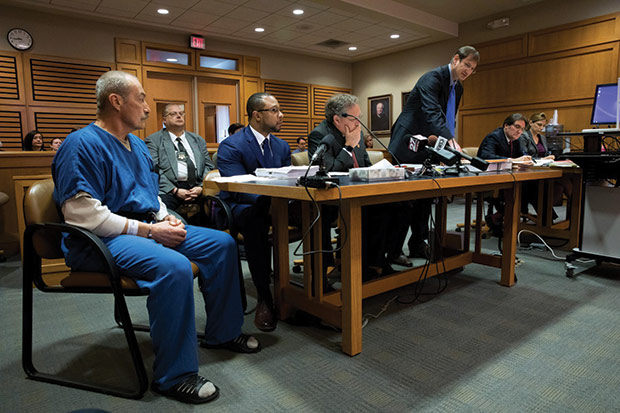State used flawed hair evidence to convict innocent people
By: Rick Benedict//May 11, 2017//
By Dee J. Hall
Wisconsin Center for Investigative Journalism

A 28-year-old mother of two was raped by a stranger in her home in rural Stoughton. Before the attack, the woman was followed around town and received menacing, sexually charged phone calls from an unknown man, whom she suspected lived nearby.
Nearly two years after the rape, which happened in 1987, Richard Beranek — who was living 130 miles away and had no known ties to the community — surfaced as a possible suspect. Chippewa County law enforcement officials thought Beranek, facing sexual assault charges there, resembled a composite sketch of the suspect in the Stoughton rape.
The woman picked Beranek out of a group of photos, telling police that she was almost certain he was the attacker. She then picked Beranek out of a live lineup.
Sealing Beranek’s fate, the FBI analyst Wayne Oakes concluded that a hair found in underwear left by the rapist in the woman’s bed was a “match” to Beranek’s hair.
At the time, however, the FBI knew microscopic hair comparison had limitations. Hair that looks identical, even under a high-powered microscope, could come from an unknown number of people. That did not stop Oakes.
Even though multiple witnesses testified at trial in 1990 that Beranek was hundreds of miles away at the time of the crime, the jury found him guilty on nine felony counts. Dane County Circuit Judge Daniel Moeser sentenced him as a repeat offender to 243 years in prison.
DNA excludes Beranek
Although Beranek remains imprisoned, the way the FBI used microscopic hair comparison has been discredited in hundreds of cases nationwide, including Beranek’s.
DNA testing has now excluded Beranek, 58, as the source of the hairs found in the perpetrator’s underwear and of sperm from the victim’s underwear, according to a motion for a new trial filed in 2016 by attorneys with the New York-based Innocence Project and the Wisconsin Innocence Project.
The Beranek case is among an estimated 3,000 in which FBI hair or fiber analysis was used before 2000, when DNA testing became widely available, and that are now scheduled for re-examination. So far, 1,600 have been reviewed, according to Vanessa Antoun, an attorney with the National Association of Criminal Defense Lawyers, who is participating in the effort.
The review has found flaws in more than 90 percent of the cases, including 13 in Wisconsin, Antoun said.
The agency’s misuse of hair evidence to convict people is “a national tragedy,” said Frederic Whitehurst, the whistleblower who revealed scientific misconduct including flawed hair analysis at the FBI laboratory in the 1990s.
“We go into court with unvalidated science,” Whitehurst said. “We know it’s unvalidated science … and we actually use this pseudo science against citizens of this nation.”
Testimony powerful — and wrong
Oakes had told jurors that “rarely, extremely rarely” was he unable to tell two hairs apart and that the suspect’s hair and Beranek’s were “microscopically the same.”
Six witnesses, however, placed Beranek 600 miles away at the time of the rape, at a relative’s home in North Dakota. But Dane County Assistant District Attorney Robert Kaiser had the powerful FBI testimony on his side.

“What an incredible coincidence,” Kaiser told the jurors. “Somehow (the victim) managed to pick out of a photo array someone in 10,000 people who had a hair that matched a hair that happened to be in her house from some unknown place.”
In 2015, the FBI acknowledged that Oakes’ testimony in Beranek’s case included “erroneous statements” in which he said or implied that the hair found at the scene “could be associated with a specific individual to the exclusion of all others.” Those statements “exceeded the limits of science,” the FBI now says.
Skip Palenik, founder of Microtrace LLC of Elgin, Ill., testified at an evidentiary hearing in February that Oakes’ statements violated professional standards that were in place even back then.
Palenik has more than 40 years’ experience examining materials under a microscope.
Absent DNA testing, hair is not unique enough to be tied to one person, he said. Two strands of hair that appear identical could be from the same person or two people “with the same type of hair,” he said.
“You can’t individualize to a certain person by microscopy,” Palenik said. “We thought you could, but we can’t.”
Hair cases under review
The Wisconsin Center for Investigative Journalism has learned that among the cases under review are: a prosecution in 1995 of Patrick W. Greer in La Crosse County — a case in which numerous errors were identified; and a case brought against Glenn Lale in Walworth County in 1985 — in which no errors were identified.
In addition to the FBI cases, there are 15 cases in which Wisconsin State Crime Laboratory analysts trained by the now-discredited FBI hairs and fibers unit performed microscopic hair comparisons, the DOJ told the Wisconsin Innocence Project. Those cases are not part of the FBI review, which is being handled by the agency, the New York-based Innocence Project and the criminal defense lawyers’ group.
Not all defendants whose cases included flawed hair analysis are innocent. But the technique has played a role in wrongful convictions nationwide. Defendants in about one-fifth of exonerations by DNA evidence were convicted at least in part with the use of hair analyses that turned out to be wrong, according to the NACDL.
Oakes — the analyst who testified in the Beranek case — had also given scientifically invalid testimony in the case of George Perrot, the FBI found. Perrot’s conviction for burglary and rape in Springfield, Mass., was overturned in 2016, and he was released after serving nearly 30 years in prison. Prosecutors have not announced whether they will retry him.
Prosecutors mum on cases
Last year, FBI Director James Comey implored governors to prod reluctant prosecutors in their states to notify defendants of the bad FBI hair analysis, warning it “could have misled a jury or judge.”
The Center has been unable to identify most of the Wisconsin cases that are being reviewed or whether defendants or their attorneys were notified. Under terms of the review, prosecutors are the only ones authorized to handle notification to the defense, said Antoun, who declined to identify the cases.
A public-records request sent by the Center in mid-February to the state Department of Justice asking for all documents related to the ongoing review yielded just a handful of pages naming three cases, including Greer’s. The Lale case was deemed to have no errors, the Center found, and the third case remains unnamed.
DOJ spokesman Johnny Koremenos said records related to the other cases would have gone back to the offices that prosecuted them, not the DOJ.
In March, the Center also requested records from the U.S. attorney’s offices in Madison and Milwaukee. Those requests are pending.
Greer received a 25-year sentence for a 1994 masked bank robbery in La Crosse County. The La Crosse Tribune reported at the time that Greer had denied involvement in the crime.
The FBI now admits that the analyst Chris Allen’s testimony identifying Greer as the likely source of hair found on the bag carrying the money was filled with errors. For example, Allen likened analysts’ ability to tie hair samples to an individual person to anyone’s ability to recognize a spouse in a crowded room.
“Everybody has a unique, finite number of features on their face,” Allen told the jury.
Greer — who was imprisoned for about 13 years before being put on parole in 2009 — was notified of the FBI review and is discussing his options with his probation agent, La Crosse County District Attorney Tim Gruenke said. Efforts to reach him were unsuccessful.
State also got hair evidence wrong
In addition to FBI cases, Comey has urged state and local authorities to expand upon his agency’s review by examining the work of their own crime-lab analysts, some of whom were trained by the FBI’s now-discredited hairs and fibers unit.
The Wisconsin Innocence Project has sought to work with the DOJ to examine those cases, but the agency has not responded to messages seeking a meeting, said the attorney Cristina Bordé.
The DOJ recently told the Innocence Project that there had been four FBI-trained analysts and 15 cases involving microscopic hair comparisons that were conducted by the state crime lab. The DOJ declined to identify the cases, citing a state law that allows it to prevent anyone outside law enforcement from getting access to forensic reports.
States including Iowa, Massachusetts and Texas are conducting reviews of their own analysts’ cases.
DOJ spokesman Koremenos said the state crime lab stopped using microscopic hair comparison about 20 years ago because of the “subjective problems of hair analysis and the advent of DNA.”
But the technique played a role in at least two wrongful convictions in Wisconsin. One of them involved Ralph Armstrong, who was convicted in 1981 for a horrific rape and murder in Madison.
In that case, the state crime lab analyst Coila Wegner used qualifying language, saying hairs found at the scene and on the victim were “similar” or “consistent” with Armstrong’s but that she could not definitively say they belonged to him. Dane County Assistant District Attorney John Norsetter brushed away those caveats, however, telling jurors that Armstrong’s hair had been found on the victim’s robe.
DNA testing later excluded Armstrong as the source of those hairs.
Armstrong served 29 years for a crime that was likely committed by his now-deceased brother, who had confessed to the crime. In February, the state, Dane County and the city of Madison agreed to pay him $1.75 million.
Decision pending in Beranek case
Here’s how the FBI got it wrong
The FBI, the New York-based Innocence Project and the National Association of Criminal Defense Lawyers are examining nearly 3,000 cases nationwide in which the FBI may have misused microscopic hair comparison.
The review so far found statements and findings that “exceeded the limits of the science” in more than 90 percent of the cases. The errors fall into three broad categories:
Claiming a ‘match’
What they did: Examiners stated or implied that the evidentiary hair could be associated with a specific individual to the exclusion of all others.
Why it was wrong: Absent DNA testing, hairs are not unique enough to be associated with one person, even by looking at them under a high-powered microscope.
Claiming a statistical weight
What they did: Examiners assigned a statistical weight, probability or likelihood that the questioned hair originated from a particular source.
Why it was wrong: No such weight can be assigned because no one knows how many people have microscopically identical hair.
Citing experience to bolster findings
What they did: Examiners cited statistics such as the number of hair cases they or the FBI lab had handled to bolster the findings.
Why it was wrong: Unlike DNA, there is no database of hair profiles. Analysts cannot memorize every hair they have ever examined. And comparing vast numbers of hairs — even billions — does not change the fact that an unknown number of people have hair that looks identical.
Sources: National Association of Criminal Defense Lawyers; FBI; Skip Palenik, Microtrace LLC.
— Dee J. Hall
Kaiser, who represented the state in the appeal in the Armstrong case, now works for the state Department of Justice as an assistant attorney general. He is leading the prosecution’s effort to block a new trial for Beranek. Moeser, the judge who sentenced Beranek 27 years ago, is retired and is hearing the appeal as a reserve judge.
At February’s evidentiary hearing, Keith Findley, co-director of the Wisconsin Innocence Project, said the defense was “a little puzzled” by the state’s opposition, given the strength of the new DNA evidence. Moeser will hear final arguments about whether Beranek’s conviction should be overturned on May 9.
During the hearing, Kaiser questioned DNA analysts in minute detail about their handling of the hairs, zeroing in on the fact that one lab had placed them on Post-it notes before mailing them.
Kaiser and Dane County Assistant District Attorney Erin Hanson argued in their objection to a new trial filed in April that the defense cannot prove the strand of hair Oakes linked to Beranek is among the hairs that now exclude him. The objection noted that the labs that handled the hairs reported either five or six strands of hair.
The prosecution also contradicted the FBI’s characterization of its own agent’s testimony, arguing that Oakes’ statements at trial were not erroneous and that “Oakes admitted that he cannot say with absolute scientific certainty that the questioned hair came from the defendant.”
In a closing statement during the hearing in February, Findley rejected the notion that a hair had been lost or that an errant hair had made its way into the evidence. And he argued that everyone, including prosecutors, the jury and the judge, was misled by Oakes’ testimony.
“We now know that the FBI hair analysis — whether in good faith or not — was simply wrong,” Findley said. “We now know that the hair that so powerfully tied Mr. Beranek to this crime actually wasn’t his.”
Beranek’s daughter, Desiree Burke, 36, attended the hearing. She said the flawed FBI analysis ripped her family apart.
“It’s not his hair. He didn’t do it,” Burke said. “I missed my whole childhood with him, my whole adult life. He’s lost so many people (while) inside, all because of this evidence.”
Legal News
- Gov. Evers seeks applicants for Dane County Circuit Court
- Milwaukee man charged in dismemberment death pleads not guilty
- Democratic-led states lead ban on the book ban
- UW Madison Professor: America’s child care crisis is holding back moms without college degrees
- History made in Trump New York trial opening statements
- Prosecutor won’t bring charges against Wisconsin lawmaker over fundraising scheme
- Republican Wisconsin Senate candidate says he doesn’t oppose elderly people voting
- Vice President Harris to reveal final rules mandating minimum standards for nursing home staffing
- Election workers fear threats to their safety as November nears
- Former law enforcement praise state’s response brief in Steven Avery case
- Eric Toney announces re-election bid for Fond du Lac County District Attorney
- Former Wisconsin Democratic Rep. Peter Barca announces new bid for Congress
WLJ People
- Power 30 Personal Injury Attorneys – Russell Nicolet
- Power 30 Personal Injury Attorneys – Benjamin Nicolet
- Power 30 Personal Injury Attorneys – Dustin T. Woehl
- Power 30 Personal Injury Attorneys – Katherine Metzger
- Power 30 Personal Injury Attorneys – Joseph Ryan
- Power 30 Personal Injury Attorneys – James M. Ryan
- Power 30 Personal Injury Attorneys – Dana Wachs
- Power 30 Personal Injury Attorneys – Mark L. Thomsen
- Power 30 Personal Injury Attorneys – Matthew Lein
- Power 30 Personal Injury Attorneys – Jeffrey A. Pitman
- Power 30 Personal Injury Attorneys – William Pemberton
- Power 30 Personal Injury Attorneys – Howard S. Sicula











